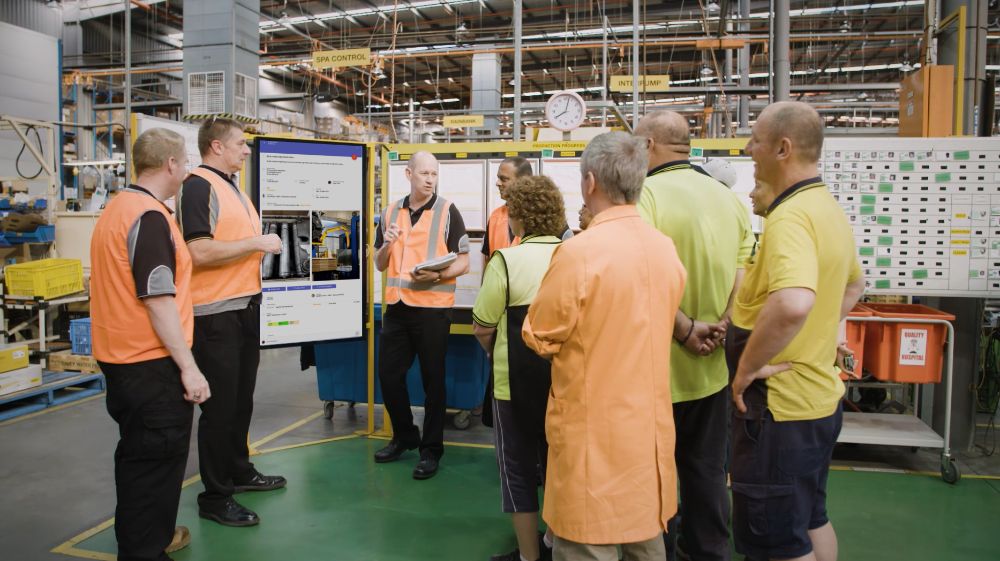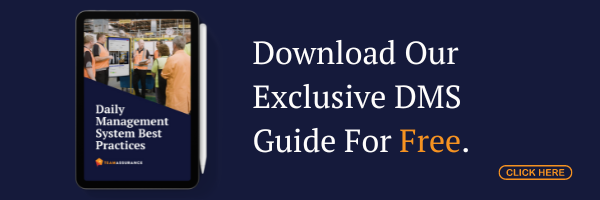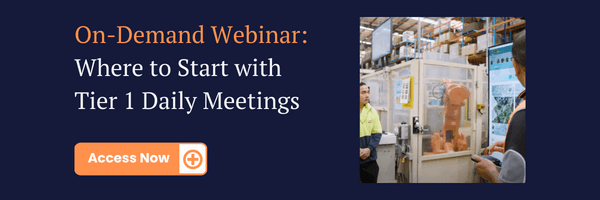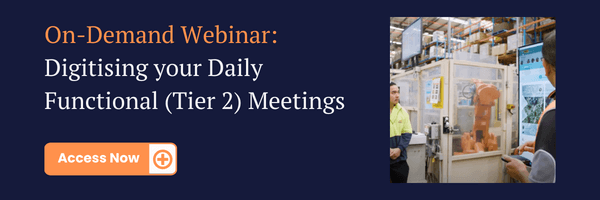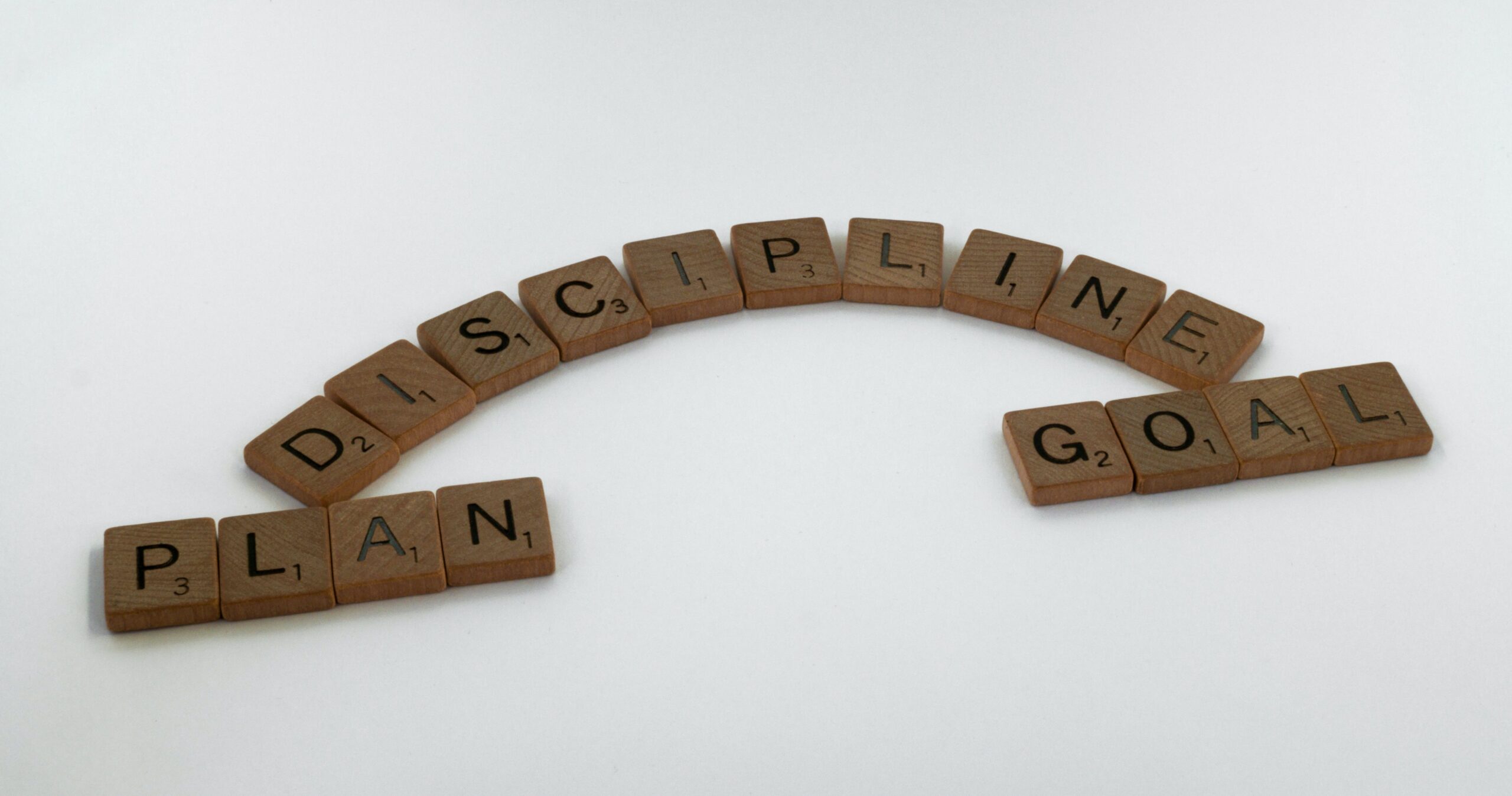Tiered Daily Management refers to structured recurrent meetings held between different levels of an organisation to manage Daily/Weekly/Monthly activity and problem-solving. These meetings can be used to share information, review progress, assign activity, make decisions, and solve or escalate issues.
When linked to the overall Business Strategy, Tiered Daily Management Represents the Single biggest Continuous Improvement Tool in the organisation, and involves 100% of your workforce across all functions and all levels.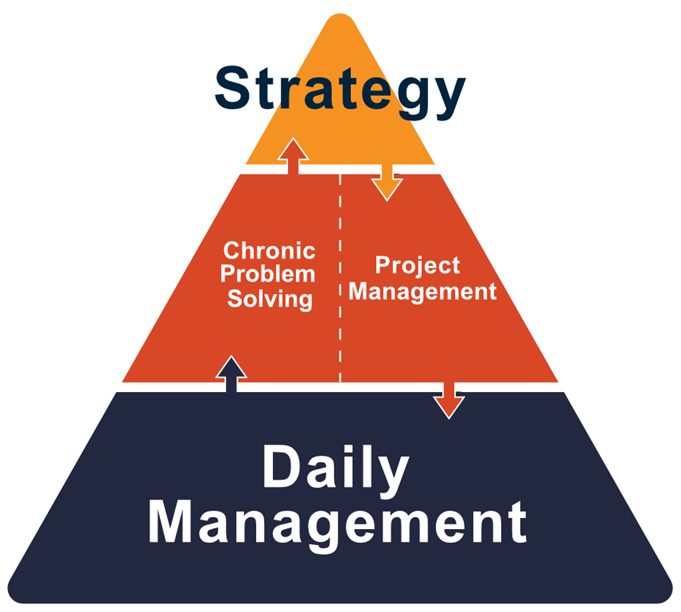
Tier meetings should be held on a regular basis. Each team and level will generally have a natural cadence that aligns with a PDCA cycles of improvement. Organisations may differ in how they divide their tiers, however it is generally a 3 or 4 tier structure.
When it comes to continuous improvement initiatives, the establishment of tiered meetings is fundamental to success. It is a structure that allows us to work on the business whilst working in the business. Addressing both the Urgent and the Important simultaneously; allowing Leaders to be both tactical and strategic in their roles.
Benefits of Tiered Meetings
There are many benefits to adopting a tiered meeting structure. These meetings help to:
- Improve communication between different levels of an organisation
- Increase learning and teamwork
- Facilitate decision-making
- Solve problems more effectively
- Improve employee morale and productivity
It may sound obvious, and perhaps simple, but getting teams together for structured, effective forums can be challenging. The benefits however, are often immediately evident – hence why establishing tiered meetings at the frontline (Level 1) should be made a priority.
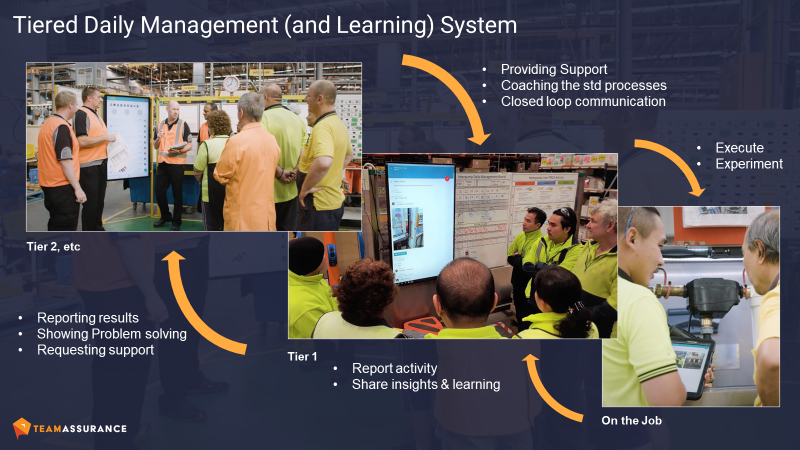
Types of Tiered Meetings
Tier meetings differ in cadence depending on the level of the organisation at which they are undertaken. Whilst it’s important to track how things are progressing on a daily basis, there are some longer term projects that may only require discussion / focus at less regular intervals.
A typical organisation will consist of three main tiers (though in some instances this extends to four). Here is an illustration of the various levels and their typical meeting cadence / focus:
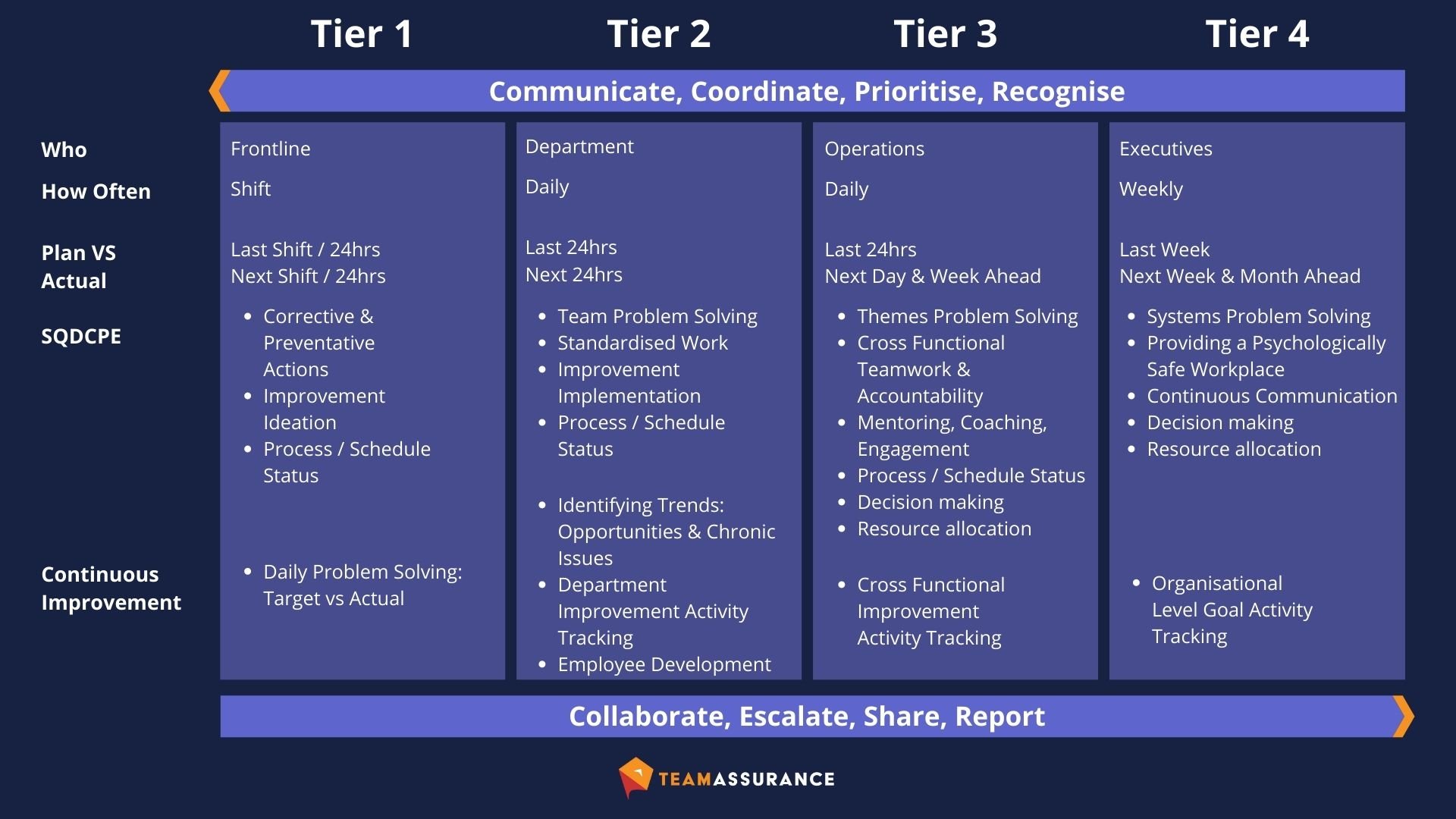
Daily Tiered Meetings
These meetings are held every day at the frontline to discuss the day’s priorities and to make sure that everyone is on the same page. They are often referred to as a ‘daily huddle’ or ‘daily management meeting’ etc.
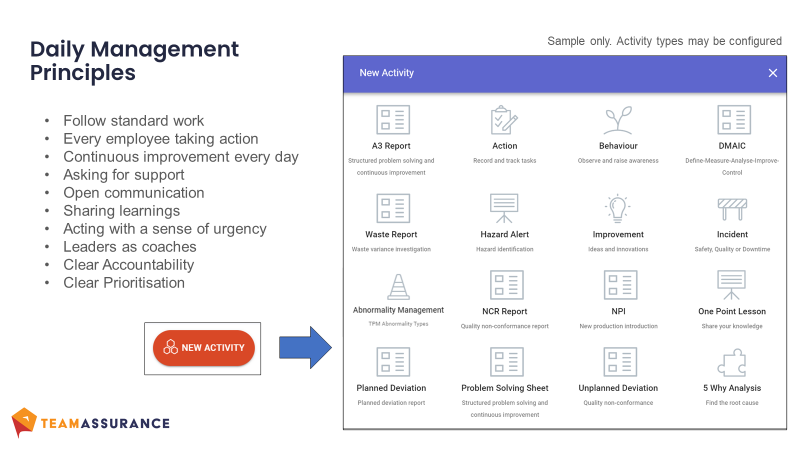
These are critical for connecting and supporting the frontline. These meetings will typically revolve around a Tier 1 Board that highlights critical information visually about core functions (safety, quality, delivery etc.).
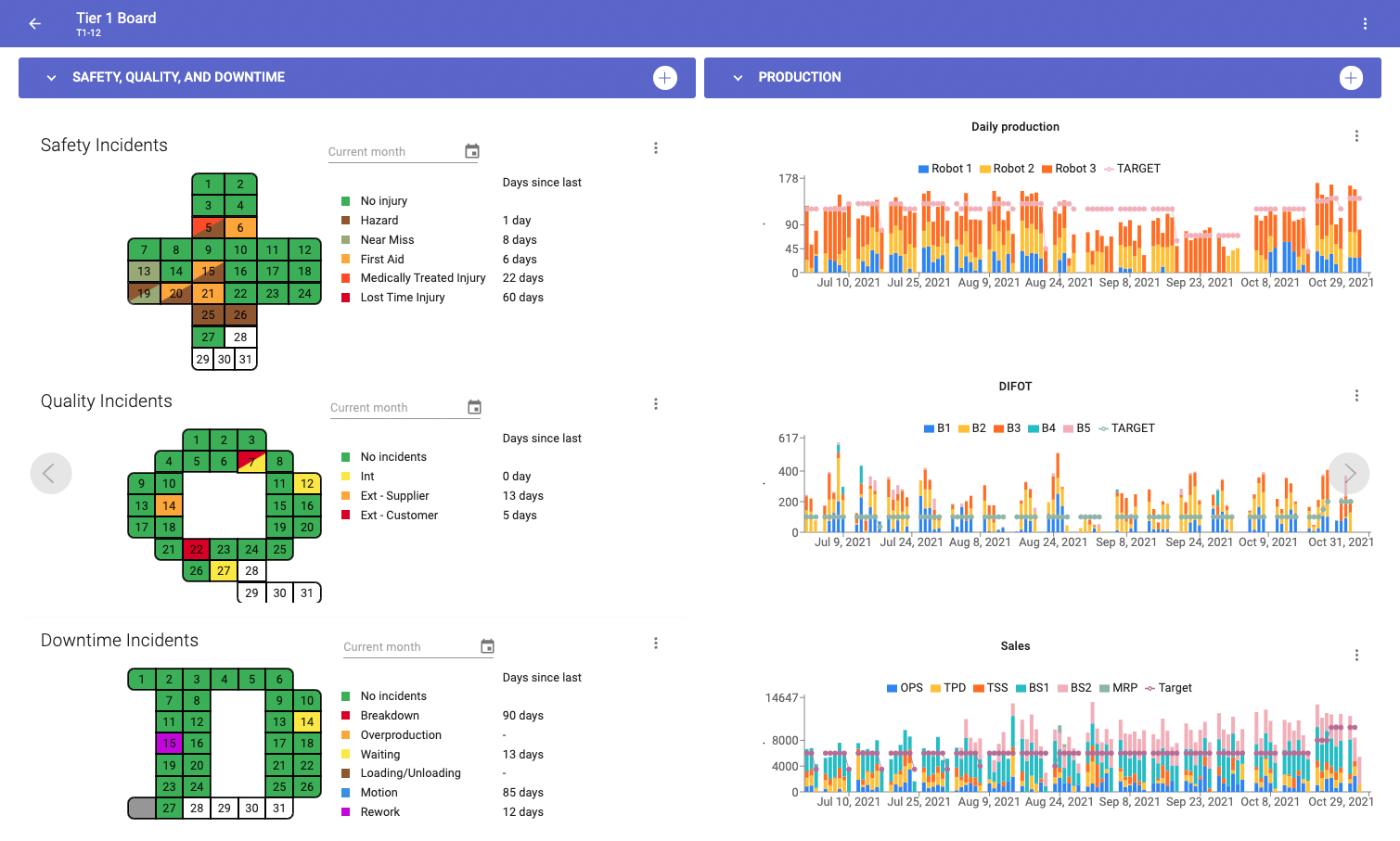
In a daily meeting participants should be reviewing and discussing the previous day / shifts performance against goals and plans for the coming shift. It is a time to share any issues, ask for resources or support where necessary and also to celebrate good performance or model behaviours.
Cadence & Agenda:
Holding 240 daily meetings per year greatly limits the breadth, depth and overall engagement levels of the Teams involved. A richer approach is to hold 4 daily’s and a weekly; 3 weekly’s and a monthly; 2 monthly’s and a quarterly. This lets leaders get the right mix of Plan-Do-Check-Act into the routine. It also lets different members of the Team own different parts of the agenda.
Weekly Tier Meetings
These meetings review progress, discuss challenges, and make plans for the upcoming week. These huddles are usually led by Team Leaders to analyse performance trends, call out new issues, and provide cross-functional support to other functions.
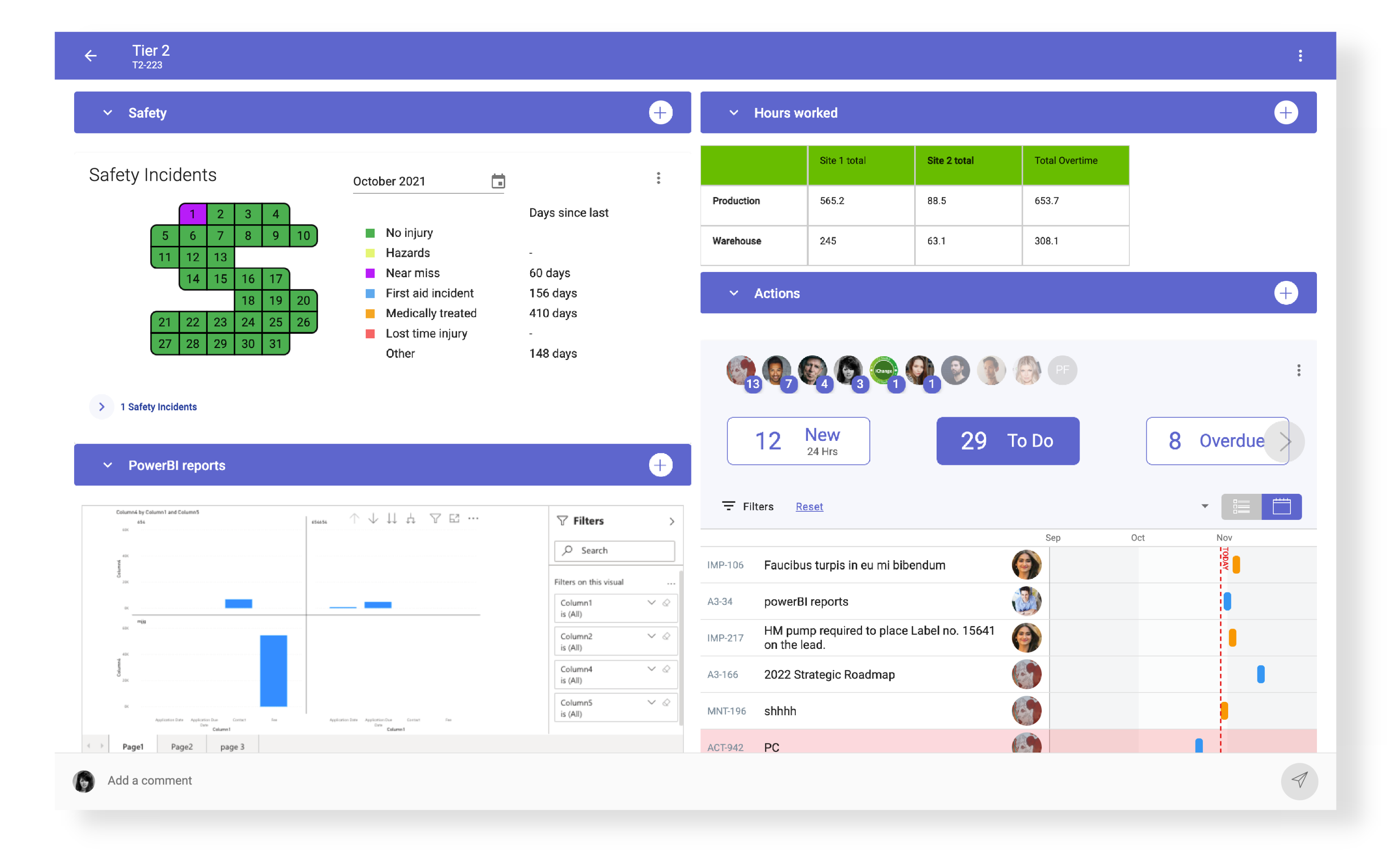
Allocation of resources, benchmarking team/shift performance, schedule adjustments, proactive reach-outs to suppliers – these are just some of the common outcomes of weekly meetings, when standing back from the day to day.
Monthly Tier Meetings
These meetings review longer-term goals, discuss progress on improvement projects, and make adjustments as needed.
A monthly review meeting should include aggregate reporting and information from our frontline teams in order to provide a holistic view of operations, as well as the escalation / resolution of chronic problems. These meetings often require some reports with a wider scope or higher complexity of query. Team member Development plans may be reviewed and strategies discussed to overcome or accelerate through the previous month’s issues.
Data Aggregation
TeamAssurance also enables you to pull data into PowerBI to overlay / create the reports you need to provide context and import back into the Tier board:
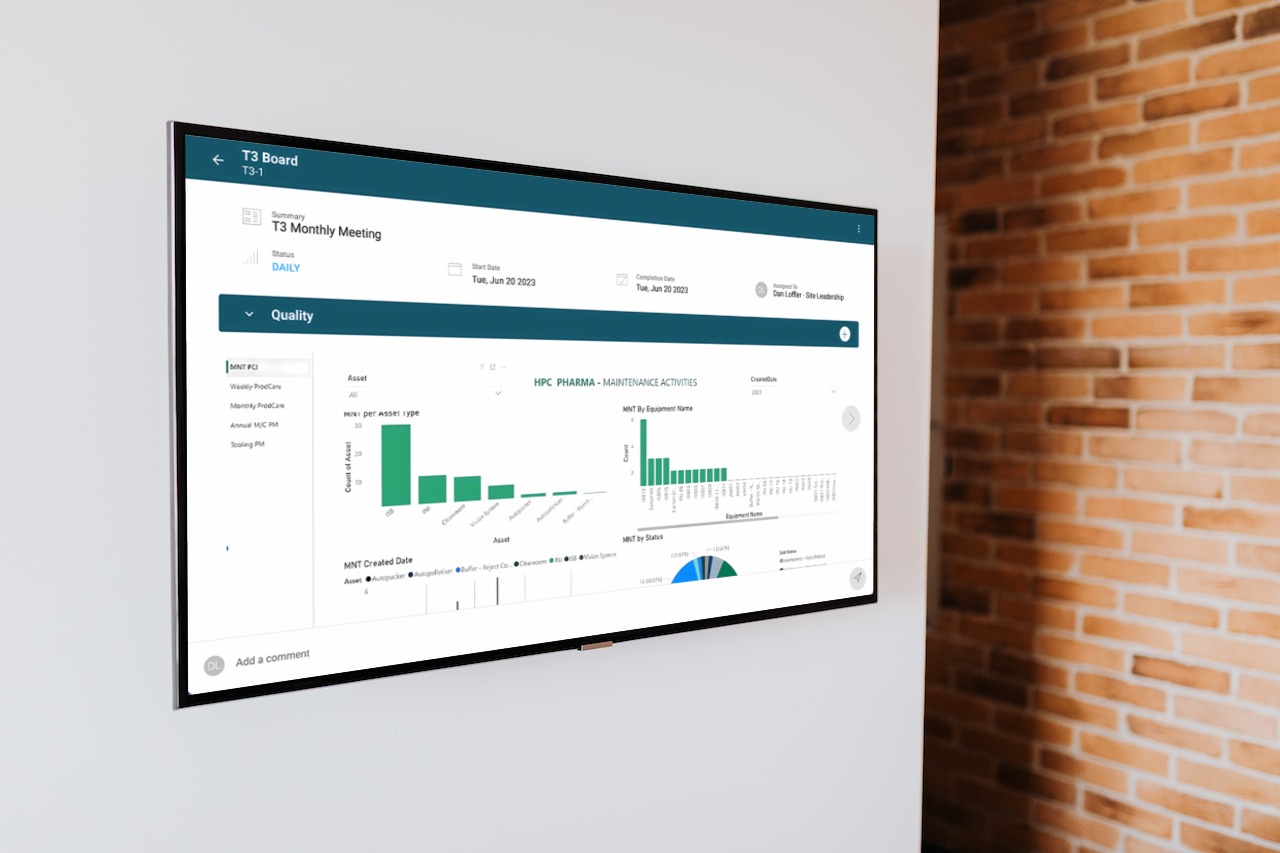
For example: paretos of poor performing assets, downtime causes, or even trends of month-on-month downtime minutes. All of these reports can be automatically prepared in real-time, ready for the executive function meetings.
Department and function leads can utilise these forums as an opportunity to course-correct longer term projects, adjust targets, celebrate successes, or share learnings. Monthly tiered meetings can also include skill-building sessions for busy leaders to support their own skills development.
Quarterly Tiered Meetings
These tiered meetings are held once a quarter to review the organisation’s overall performance and to make key strategic decisions. The executive tier can get aligned on objectives, collaborate on endemic issues that have been escalated, and make wholesale decisions based on all inputs from the organisation.
Visual reports that showcase trends over time, and aggregate individual team data are key to helping leaders make informed decisions.

Preparation for these meetings can be tedious and laborious when data isn’t easily accessible or is held across multiple systems. We often find this to be a pain point for organisation leaders. One that leads to more administrative work for support staff, or even quarterly tiered meetings being postponed or missed.
Quarterly cadences should be led by the executive level – but that doesn’t mean execs shouldn’t have their finger on the pulse from day-to-day. An interconnected, accessible, real-time daily management system will support this, as well as ensure appropriate information is available at the quarterly meeting.
Tiered Meeting Structure
There is no one-size-fits-all approach to structuring a tier meeting. However, there are some general tips that can help to ensure that your meetings are productive and effective.
-
Set clear goals and objectives for each of your tiered meetings
Before you hold your meeting, take some time to think about what you hope to accomplish. What information do you need to share? What decisions do you need to make? Once you have a clear understanding of your goals, you can start to plan your meeting accordingly.
-
Invite the right people
Not everyone in your organization needs to attend every tier meeting. Only invite the people who are essential to the discussion. This will help to keep your meetings focused and productive.
-
Create an agenda
An agenda will help to keep your meeting on track. Before you start your meeting, take some time to create an agenda that lists the topics that you want to discuss. This will help to ensure that you cover everything that you need to cover.
-
Start and end on time
People’s time is valuable. Start and end your meetings on time to show respect for your attendees.
-
Encourage participation in tiered meetings
Tier meetings are a great opportunity for different levels of an organization to collaborate and share ideas. Encourage everyone to participate in the discussion. This will help to ensure that everyone is on the same page and that everyone’s ideas are heard.
-
Summarise the tiered meetings (and next steps)
At the end of your meeting, take some time to summarise the discussion and to identify next steps. This will help to ensure that everyone is on the same page and that everyone knows what they need to do.
Example Agenda for Daily Tiered Meetings
Here is are the general elements for a daily tier 1 meeting agenda:
- Review of yesterday’s goals and objectives:
- Review what was accomplished yesterday, identify any challenges that were encountered, set follow up tasks.
- Discussion of today’s goals and objectives:
- Discuss what needs to be accomplished today and identify any potential challenges.
- Brainstorming:
- Brainstorm solutions to any challenges that were identified. Set follow-up tasks as necessary.
- Confirm Next Steps & Accountabilities:
- Reiterate next steps / expectations and assign tasks. Ensure there are no orphaned activities.
In order to run efficient, effective meetings it is key to keep meetings on track by sticking to information presented in the DMS. That’s where having linked visual reports, activity lists, checklists and raised hazards / model behaviours comes in handy.
It ensures our teams are focused on addressing hard data, contributing information ahead of the meeting rather than wasting time on gathering data or meeting administration.
If you are wondering where to start with Daily Tier 1 Meetings, the answer is easier than you think. Begin with the mindset to eliminate the barriers your Team experience every day that prevent them from achieving their targets. They are experts in these problems, and it is usually the leaders that need to learn here. Separating what is in their control vs. what needs support is the very next step of the Team Leader. (Tip: there is always lots of improvement opportunities within their control!)
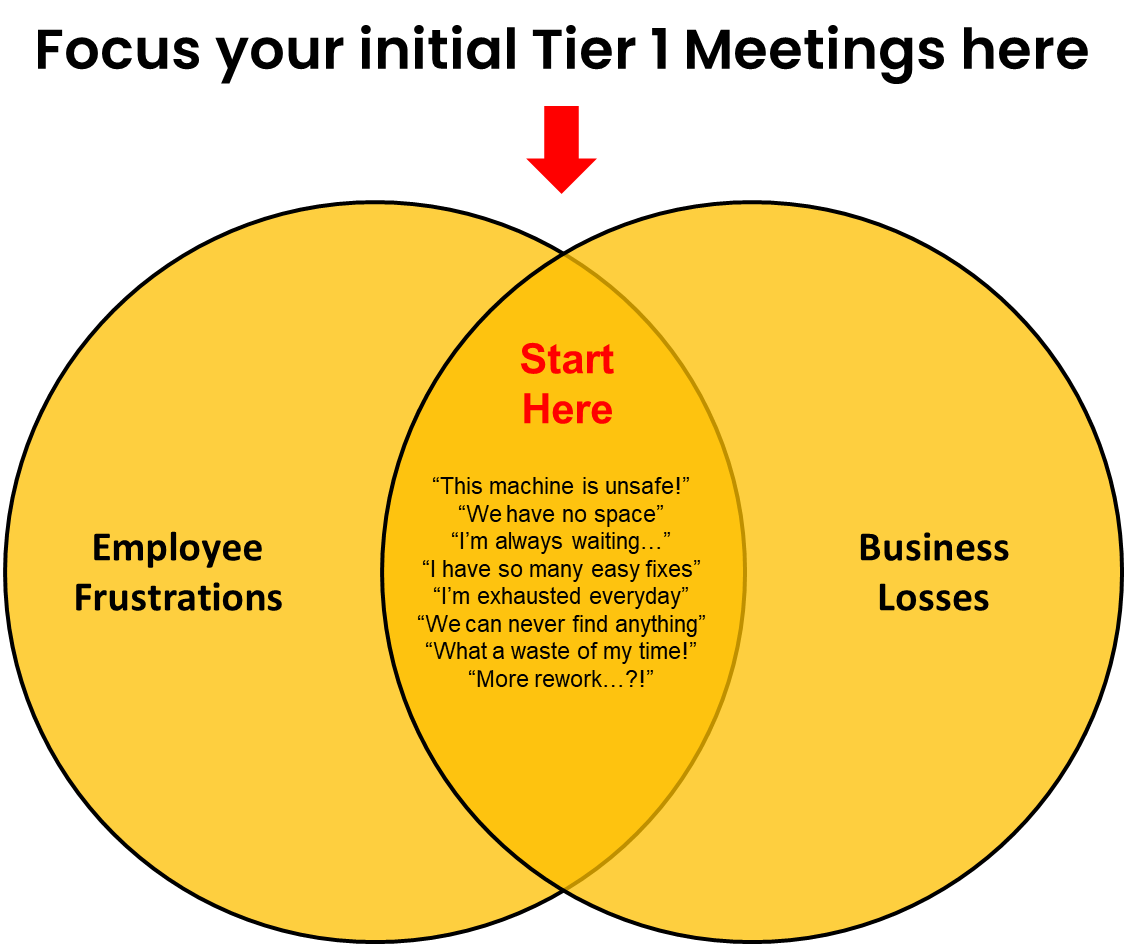
Using TeamAssurance to Support Tier Meetings
The TeamAssurance platform was built to support critical Daily Management activities. When it comes to tiered meetings, our connected worker platform enables staff to contribute at the frontline, using mobile devices. This ensures that information is captured for review in tier meetings, there is no administrative burden and communication and coordination is enhanced.
It can also help to identify and resolve problems more quickly.
This case study from Pact Group is a great example of how TeamAssurance has embedded a tiered meeting structure and transformed their continuous improvement processes:
Here are some specific examples of how our digital DMS can support tier meetings:
- Creating and sharing agendas: TeamAssurance makes it easy for team leaders to create and share agendas for tier meetings. This helps to ensure that all team members are aware of the topics that will be discussed and that they have time to prepare.
- Tracking progress on action items: TeamAssurance can be used to track progress on action items that are identified during tier meetings. This helps to ensure that action items are not forgotten and that they are completed in a timely manner.
- Storing meeting minutes: TeamAssurance can be used to store meeting minutes. This helps to ensure that everyone has access to the minutes, and that they can be easily referenced at a later date.
- Collecting and analysing data: TeamAssurance can be used to collect and analyse data from tier meetings and during a shift. This data can be used to identify trends, track performance, and make improvements to the process.
- By using TeamAssurance, organisations can improve the effectiveness of their tier meetings. This can lead to improved communication, coordination, and problem-solving, which can ultimately lead to improved operational performance.
You can see all of this in action on an interactive tier board. Simply set up a screen – be it a touchscreen kiosk, computer monitor, or TV – and make your meetings meaningful.
Viewing the Tier Meeting as part of the greater C.I. Framework
Tier meetings aid in the alignment of our people, processes and systems. However, we must remember that it is one part of a greater continuous improvement framework. Other Lean tools like standardised problem solving techniques, Standard Operating Procedures (SOPs), and a Tiered Daily Management process that supports our full PDCA loop are also key to achieving success over both the short and long term.
This illustration below demonstrates how we designed the TeamAssurance platform to avoid locally optimised, disconnected ‘Point Solutions’ (digital or analog) that can hinder your progress towards the organisation’s goals.
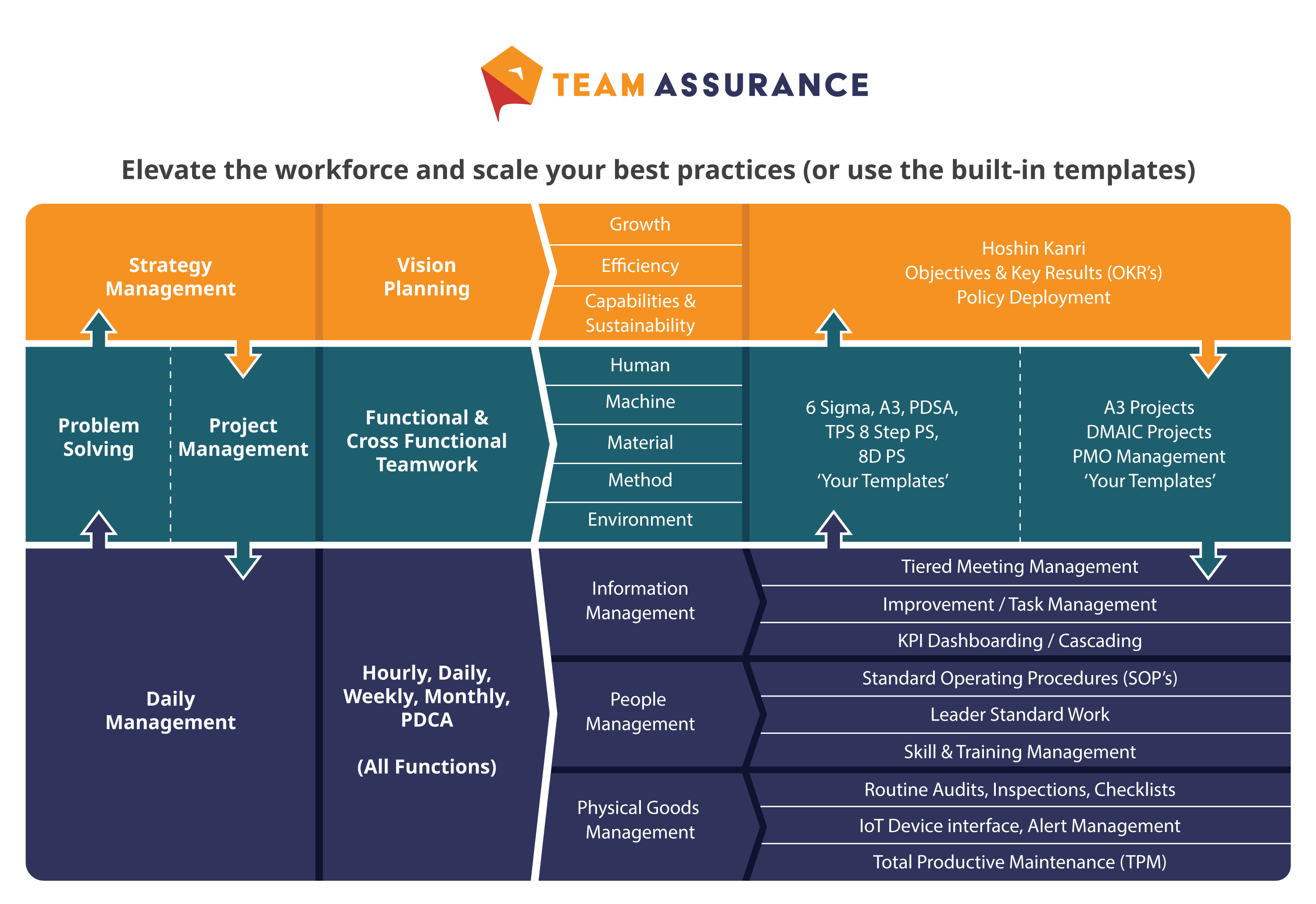
If you’re a business in need (or a consultant with clients in need) and you’d like to explore the opportunities that digital-aids to Lean tools provide contact us for a demonstration of the TeamAssurance platform today

